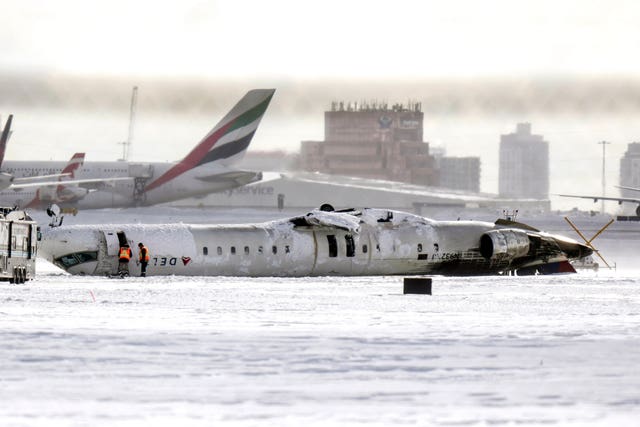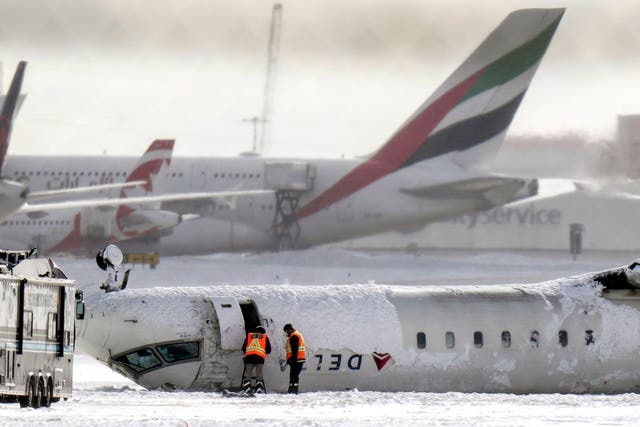All 80 people on board Delta jet survive after it flips on Toronto runway
The passenger plane lost its right wing and burst into flames, leaving 18 injured.

The Delta Air Lines jet came down fast and wobbled so hard that it lost its right wing and burst into flames on a runway in Toronto. The aircraft slid to a stop, upside down, leaving a trail of black smoke in its wake.
Miraculously, all 80 people on board the flight from Minneapolis to Toronto’s Pearson International Airport survived the crash on Monday.
Most of them walked away with minor injuries, the airport’s chief executive said.
Authorities said the cause of the crash remains under investigation. Communications between the tower and pilot were normal on approach and it is not clear what went wrong when the plane touched down.
At the time of the flight’s arrival, the airport was experiencing blowing snow and winds of 32 mph (51 kph) gusting to 40 mph (65 kph), according to the Meteorological Service of Canada. The temperature was about minus 8.6 degrees Celsius.
Peter Carlson, a passenger travelling to Toronto for a paramedics conference, said the landing was “very forceful”.
“All the sudden everything just kind of went sideways and the next thing I know, it’s kind of a blink and I’m upside down still strapped in,” he told CBC News.
Canadian authorities held two brief news conferences on Monday but provided few details. The aircraft was a Mitsubishi CRJ-900 made by the Canadian company Bombardier.
“We are very grateful there was no loss of life and relatively minor injuries,” Deborah Flint, chief executive of Greater Toronto Airports Authority, told reporters.
Delta chief executive Ed Bastian said in a statement that “the hearts of the entire global Delta family are with those affected”.

A commercial jetliner and an Army helicopter collided near Reagan National Airport in Washington, DC, on January 29, killing 67 people.
A medical transportation plane crashed in Philadelphia on January 31, killing the six people on board and another person on the ground.
And on February 6, 10 people were killed in a plane crash in Alaska.
The last major crash at Pearson was on August 2 2005, when an Airbus A340 from Paris skidded off the runway and burst into flames in stormy weather. All 309 passengers and crew aboard Air France Flight 358 survived.
The Delta flight on Monday was cleared to land at about 2.20pm. Audio recordings show the control tower warned the pilots of a possible air flow “bump” on approach.
“It was windy, but the airplanes are designed and certified to handle that,” said John Cox, chief executive of aviation safety consulting firm Safety Operating Systems in St Petersburg, Florida. “The pilots are trained and experienced to handle that.”
The plane came to a rest at the intersection of Runways 23 and 15L.

Mr Carlson and another man assisted a mother and her young son out of the plane and then Mr Carlson dropped onto the tarmac. He said snow was blowing but “I didn’t care how cold it was, didn’t care how far I had to walk, how long I had to stand — all of us just wanted to be out of the aircraft.”
Mr Cox, who flew for US Air for 25 years and has worked on US National Transportation Safety Board (NTSB) investigations, said the CRJ-900 has been in service for decades and does a good job of handling inclement weather, but that it’s unusual for any plane to end up on its roof.
“We’ve seen a couple of cases of takeoffs where airplanes have ended up inverted, but it’s pretty rare,” Mr Cox said.
Among the questions that need to be answered, Mr Cox said, is why the crashed plane was missing its right wing. He said the flight data recorder and cockpit voice recorder will be imperative to understanding what actually occurred.
The US Federal Aviation Administration said in a statement that the Transportation Safety Board of Canada would head up the investigation and provide any updates.
The NTSB in the US said it was sending a team to assist.
Endeavor Air, based in Minneapolis, is a subsidiary of Delta Air Lines and the world’s largest operator of CRJ-900 aircraft. The airline operates 130 regional jets on 700 daily flights to over 126 cities in the US, Canada and the Caribbean, according to the company’s website.





